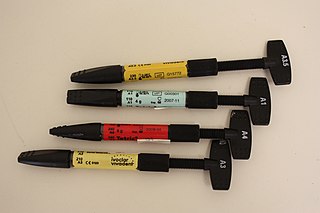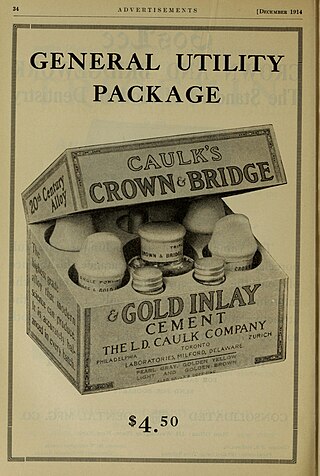Related Research Articles

Tooth enamel is one of the four major tissues that make up the tooth in humans and many animals, including some species of fish. It makes up the normally visible part of the tooth, covering the crown. The other major tissues are dentin, cementum, and dental pulp. It is a very hard, white to off-white, highly mineralised substance that acts as a barrier to protect the tooth but can become susceptible to degradation, especially by acids from food and drink. In rare circumstances enamel fails to form, leaving the underlying dentin exposed on the surface.
Dental products are specially fabricated materials, designed for use in dentistry. There are many different types of dental products, and their characteristics vary according to their intended purpose.
Dental restoration, dental fillings, or simply fillings are treatments used to restore the function, integrity, and morphology of missing tooth structure resulting from caries or external trauma as well as to the replacement of such structure supported by dental implants. They are of two broad types—direct and indirect—and are further classified by location and size. A root canal filling, for example, is a restorative technique used to fill the space where the dental pulp normally resides.
Tooth whitening or tooth bleaching is the process of lightening the color of human teeth. Whitening is often desirable when teeth become yellowed over time for a number of reasons, and can be achieved by changing the intrinsic or extrinsic color of the tooth enamel. The chemical degradation of the chromogens within or on the tooth is termed as bleaching.
Dental sealants are a dental treatment intended to prevent tooth decay. Teeth have recesses on their biting surfaces; the back teeth have fissures (grooves) and some front teeth have cingulum pits. It is these pits and fissures that are most vulnerable to tooth decay because food and bacteria stick in them and because they are hard-to-clean areas. Dental sealants are materials placed in these pits and fissures to fill them in, creating a smooth surface which is easy to clean. Dental sealants are mainly used in children who are at higher risk of tooth decay, and are usually placed as soon as the adult molar teeth come through.

In dentistry, a crown or a dental cap is a type of dental restoration that completely caps or encircles a tooth or dental implant. A crown may be needed when a large dental cavity threatens the health of a tooth. A crown is typically bonded to the tooth by dental cement. They can be made from various materials, which are usually fabricated using indirect methods. Crowns are used to improve the strength or appearance of teeth and to halt deterioration. While beneficial to dental health, the procedure and materials can be costly.

Dental composite resins are dental cements made of synthetic resins. Synthetic resins evolved as restorative materials since they were insoluble, of good tooth-like appearance, insensitive to dehydration, easy to manipulate and inexpensive. Composite resins are most commonly composed of Bis-GMA and other dimethacrylate monomers, a filler material such as silica and in most applications, a photoinitiator. Dimethylglyoxime is also commonly added to achieve certain physical properties such as flow-ability. Further tailoring of physical properties is achieved by formulating unique concentrations of each constituent.

Abrasion is the non-carious, mechanical wear of tooth from interaction with objects other than tooth-tooth contact. It most commonly affects the premolars and canines, usually along the cervical margins. Based on clinical surveys, studies have shown that abrasion is the most common but not the sole aetiological factor for development of non-carious cervical lesions (NCCL) and is most frequently caused by incorrect toothbrushing technique.

In dentistry, inlays and onlays are used to fill cavities, and then cemented in place in the tooth. This is an alternative to a direct restoration, made out of composite, amalgam or glass ionomer, that is built up within the mouth.

Early childhood caries (ECC), formerly known as nursing bottle caries, baby bottle tooth decay, night bottle mouth and night bottle caries, is a disease that affects teeth in children aged between birth and 71 months. ECC is characterized by the presence of 1 or more decayed, missing, or filled tooth surfaces in any primary tooth. ECC has been shown to be a very common, transmissible bacterial infection, usually passed from the primary caregiver to the child. The main bacteria responsible for dental caries are Streptococcus mutans and Lactobacillus. There is also evidence that supports that those who are in lower socioeconomic populations are at greater risk of developing ECC.
Zinc phosphate is an inorganic compound with the formula Zn3(PO4)2. This white powder is widely used as a corrosion resistant coating on metal surfaces either as part of an electroplating process or applied as a primer pigment (see also red lead). It has largely displaced toxic materials based on lead or chromium, and by 2006 it had become the most commonly used corrosion inhibitor. Zinc phosphate coats better on a crystalline structure than bare metal, so a seeding agent is often used as a pre-treatment. One common agent is sodium pyrophosphate.

A glass ionomer cement (GIC) is a dental restorative material used in dentistry as a filling material and luting cement, including for orthodontic bracket attachment. Glass-ionomer cements are based on the reaction of silicate glass-powder and polyacrylic acid, an ionomer. Occasionally water is used instead of an acid, altering the properties of the material and its uses. This reaction produces a powdered cement of glass particles surrounded by matrix of fluoride elements and is known chemically as glass polyalkenoate. There are other forms of similar reactions which can take place, for example, when using an aqueous solution of acrylic/itaconic copolymer with tartaric acid, this results in a glass-ionomer in liquid form. An aqueous solution of maleic acid polymer or maleic/acrylic copolymer with tartaric acid can also be used to form a glass-ionomer in liquid form. Tartaric acid plays a significant part in controlling the setting characteristics of the material. Glass-ionomer based hybrids incorporate another dental material, for example resin-modified glass ionomer cements (RMGIC) and compomers.

A luting agent is a dental cement connecting the underlying tooth structure to a fixed prosthesis. To lute means to glue two different structures together. There are two major purposes of luting agents in dentistry – to secure a cast restoration in fixed prosthodontics, and to keep orthodontic bands and appliances in situ.
In dentistry, the configuration factor refers to the number of bonded surfaces in an adhesive dental restoration. Because adhesive dental restorative material will adhere to the walls of a cavity preparation made available to it during polymerization, competing forces can arise during restoration of the tooth that can have both short and long term effects that correlate to the configuration of the cavity preparation.

In dentistry, amalgam is a liquid mercury and metal alloy mixture used to fill cavities caused by tooth decay.
Dental cements have a wide range of dental and orthodontic applications. Common uses include temporary restoration of teeth, cavity linings to provide pulpal protection, sedation or insulation and cementing fixed prosthodontic appliances. Recent uses of dental cement also include two-photon calcium imaging of neuronal activity in brains of animal models in basic experimental neuroscience.
Mineral trioxide aggregate (MTA) was developed for use as a dental root repair material by Mahmoud Torabinejad. It is formulated from commercial Portland cement, combined with bismuth oxide powder for radio-opacity. MTA is used for creating apical plugs during apexification, repairing root perforations during root canal therapy, and treating internal root resorption. This can be used for root-end filling material and as pulp capping material. Originally, MTA was dark gray in color, but white versions have been on the market since 2002.
Minimal intervention dentistry is a modern dental practice designed around the principal aim of preservation of as much of the natural tooth structure as possible. It uses a disease-centric philosophy that directs attention to first control and management of the disease that causes tooth decay—dental caries—and then to relief of the residual symptoms it has left behind—the decayed teeth. The approach uses similar principles for prevention of future caries, and is intended to be a complete management solution for tooth decay.
Dental compomers, also known as polyacid-modified resin composite, are used in dentistry as a filling material. They were introduced in the early 1990s as a hybrid of two other dental materials, dental composites and glass ionomer cement, in an effort to combine their desirable properties: aesthetics for dental composites and the fluoride releasing ability for glass ionomer cements.
Atraumatic restorative treatment (ART) is a method for cleaning out tooth decay from teeth using only hand instruments and placing a filling. It does not use rotary dental instruments to prepare the tooth and can be performed in settings with no access to dental equipment. No drilling or local anaesthetic injections are required. ART is considered a conservative approach, not only because it removes the decayed tissue with hand instruments, avoiding removing more tissue necessary which preserves as much tooth structure as possible, but also because it avoids pulp irritation and minimises patient discomfort. ART can be used for small, medium and deep cavities caused by dental caries.